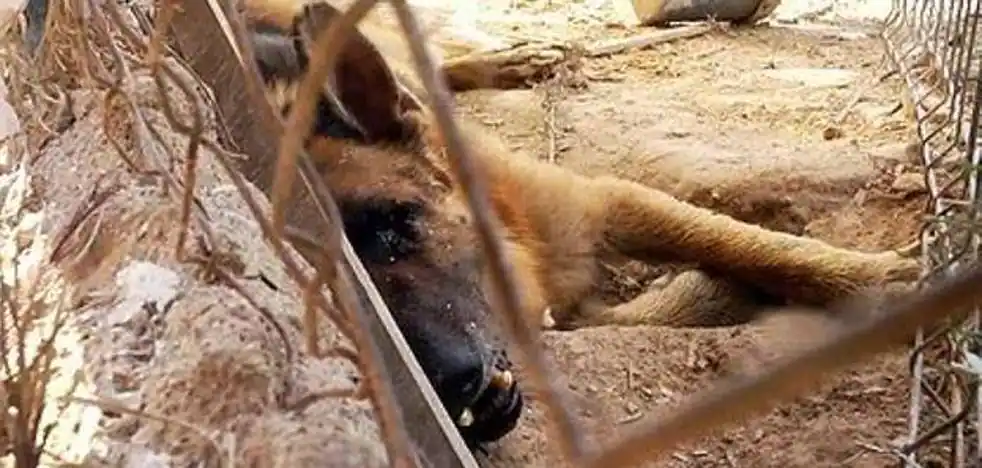A dog is dying on a farm in Murcia, in a file image. /
They celebrate the ethical progress of the norm, they doubt that zero sacrifice allows control of cat colonies and they trust that respect for biodiversity will be depoliticized and prevail
Abolish mistreatment, uncontrolled breeding and the abandonment of domestic animals, in which Spain is in the ‘top European’; Shielding their rights, establishing the obligations of their owners and punishing non-compliance more harshly, in addition to achieving zero sacrifice and unifying regulations at the state level are the main objectives of the Animal Protection, Rights and Welfare Bill, to which this week The Council of Ministers gave the green light and in September it will return to the Congress of Deputies to continue processing it.
This is how María Marín, spokesperson in the United Podemos Regional Assembly and veterinarian, summarizes it, recalling that “it is one of the commitments of the governance agreement of the PSOE-UP coalition and a citizen demand for a long time.”
Although the draft bill arrived surrounded by noise and controversy, the truth is that ecologists, scientists and jurists positively value this regulation, who trust that it will improve some of the failures and contradictions that it contains in the pending process. “It is a very important ethical advance that responds to the growing social feeling and has very strong approaches to raising awareness of animal rights as sentient beings,” environmental lawyer Eduardo Salazar analyzes the rule, something on which the UP and PSOE agree, as well as the dean of the Faculty of Veterinary Medicine of the UMU, Gaspar Ros. And he defines it as “a general framework of protection that establishes some novel obligations and others that are highly demanded”, in addition to toughening the penalties against offenders, he values him.
“In the evaluation of dangerous dogs, genetics should have weight”, values Cobrm
“This law was very controversial due to the false information that was spread. The problem is that it is born from the politicization of animalism and animal welfare must be above that and be based on scientific criteria, “says Ricardo Navarro, head of the veterinary service of Terra Natura Murcia, researcher and associate professor in Veterinary Medicine at the UMU .
The rule “aims to put an end to petism and it seems good to me,” adds Navarro, who warns that we must also think about the consequences. And he points out that in the Region there may be problems with wild animals, for example, with meerkats, “which became fashionable for ‘Timón’ from the ‘Lion King’ and, for fear of sanctions, they can be abandoned causing problems, as happened with parrots, barnacles in Sierra Espuña or Vietnamese pigs in Los Mateos (Cartagena)».
Training courses for all pet owners generate controversies and doubts
Felines and biodiversity
Everyone celebrates that he aspires to eradicate the illegal breeding and possession of wild species and to put an end to the existence of stray animals or that they are used as “fair monkeys”, although they do not completely agree with the methods for this. This is the case of the Official Association of Biologists of Murcia (Cobrm), which points out the CER method (capture, sterilization and return) as insufficient to control the abundant population of stray cats that are “the first cause of extinction of biodiversity on the planet” , says Ecologists in Action (EEA).
They are also in favor of complementing sterilization with slaughter in exceptional cases – specimens with chronic pathologies or colonies in natural spaces – “never as a single strategy”. And they add that, in this aspect, the new regulations seem to contradict the Biodiversity Law. «For Ecologists in Action, for the sake of biodiversity, which must prevail because, after climate change, it is the second biggest problem on the planet, zero sacrifice does not have much justification». Salazar also refers to this dangerous potential for biodiversity. And Gaspar Ros points out another underlying problem: “Who is legally responsible for these ‘community’ cats -the law calls them-“; and although he defends the CER system to control the impact of cats on nature, he recalls that “the health of animals is that of humans, because they act as a filter against diseases.”
excessive bureaucracy
Another of the criticized issues is the excessive bureaucracy generated by the new standard and which, they believe, will complicate its application. “It establishes a very intense administrative intervention system: planning, registration, listing, regulations for pet owners and possession, adoption or assignment,” Salazar lists. To which the dean of veterinarians adds that “there are many issues that technically must be reviewed to see the capacities that are available and the social reality that we have,” he says, referring to the bodies established by the law and the resources of the administrations who should be responsible for applying it.
Also controversial is, for the dean of Cobrm, David Hernández, the disappearance of potentially dangerous dog breeds (PPP) and their assessment by behavior –ethology–, a test that veterinarians must carry out. On the one hand, he justifies, because «genetics should weigh more. We must not forget that the races are the result of selection to obtain better hunters, more efficiency in attack and defense…; nor that, to establish its dangerousness, it is necessary to assess the mandibular power. A Belgian shepherd, with 426 newtons per cm2, is not the same as a Pekingese, however aggressive it may be, which does not reach 50”, explains Hernández. And he points to the “economic and scientifically unfounded end” of this decision, which will force families to go through the checkout, both from veterinary clinics -for their evaluation- and from insurers.
Fewer restrictions on access
The norm awakens unanimity in that the full weight of the law falls on abusers and illegal breeders of wild species, very abundant; and in the integration of pets in all areas of life, since the law limits the veto of access to public places and establishments. However, it also generates conflict in matters such as training for animal owners, the contents of which are not specified, although it is free; and doubts regarding the positive list of wild species that can be commercialized and kept in the domestic sphere. “Almost no European country has yet prepared it and the law gives a 48-month term,” details EEA.
demand consensus
For their part, from the PP they defend their commitment to animal protection and recall that animal protectors are already included in the regional law on Patronage. However, considers the PP, «regulation should be addressed by agreeing on a text with the affected sectors and agreeing on it with communities and municipalities. It is intolerable for the law to prevail.” And he proposes that this new text take into account “the particularities and characteristics of animals that are dedicated to professional activities.”
“In zoos, we must study and conserve, and train people”
Although at first it was feared that the zoos would be exempt from content – there was talk that they would only host native species – finally the law does not go into these issues, although it does require that they become centers that are not limited to mere exhibition.
“Zoos must be in constant evolution, we must be required to investigate, conserve and train people, and to collaborate with the authorities when required,” says Ricardo Navarro, from Terra Natura Murcia, who explains that, as a center of the European Association of Zoos and Aquariums (Eaza) and its counterpart on the Peninsula (Aiza), meet much more demanding criteria. “We are a first class center,” he says. And he explains that “the 3Rs – rescue, rehabilitation and reintroduction, conservation and research, which govern them – are the future”.
In the opinion of the veterinarian responsible for the Murcian zoo, the law will not affect its operation. Not in vain, he explains, they have been working for years with the Biology and Veterinary Faculties of the UMU. And he recalls that facilities of this type advance in the knowledge of wild species: “We were the first to detect leishmania in the Iberian otter and to treat it successfully,” he exemplifies.
#Researchers #biologists #demand #scientific #criteria #prevail #Animal #Welfare #Law










